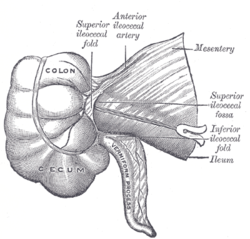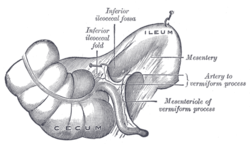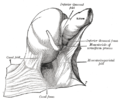Ileocecal fold
| Ileocecal fold | |
|---|---|
 Superior ileocecal fossa. | |
 Inferior ileocecal fossa. | |
| Details | |
| Identifiers | |
| Latin | plica ileocaecalis |
| TA98 | A10.1.02.421 |
| TA2 | 3788 |
| FMA | 16532 |
| Anatomical terminology | |
The ileocecal fold or ileocaecal fold is an anatomical structure in the human abdomen, located between the ileum and the cecum. It is formed by a layer of peritoneum. The upper border is fixed to the ileum, opposite its mesenteric attachment, while the lower border passes over the ileocecal junction to join the mesentery of the vermiform process, and sometimes the process itself. Behind the fold is the inferior ileocecal fossa. The structure is also called the ligament, veil, or bloodless fold of Treves after English surgeon Sir Frederick Treves.[1]
Additional images
-
The cecal fossa. The ileum and cecum are drawn backward and upward.
References
![]() This article incorporates text in the public domain from page 1160 of the 20th edition of Gray's Anatomy (1918)
This article incorporates text in the public domain from page 1160 of the 20th edition of Gray's Anatomy (1918)
- ^ Sir Frederick Treves at whonamedit.com

